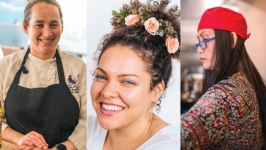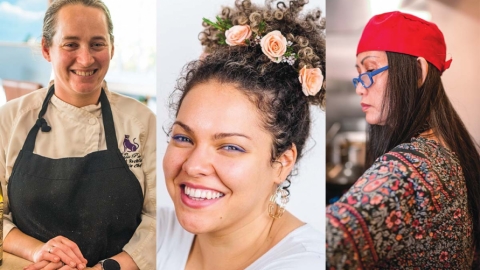Nisachon Rung Morgan
Chef Rung Morgan clasps her hands together, brings them in front of her face, and bows her head slightly to express gratitude. She’s been doing a lot of bowing this past year, ever since she was named Best Chef in the Northeast by the James Beard Foundation in June 2022.
“I didn’t know who was James Beard,” says the Thai native. “But now I know it’s a big deal.”
Her husband and fellow chef, Steve Morgan, knew exactly who James Beard was, and he understood the impact that a nod from the most prestigious culinary foundation in the country could do for a small restaurant like Saap. Located in a Victorian mansion at the bottom of a dead-end road in Randolph, Saap has introduced authentic northern Thai cuisine to central Vermont. A secret treasure for several years after it opened in 2014, diners now make the pilgrimage to Saap from all over the country.
Rung grew up in the Isan region of Thailand, in the northeast corner bordering on Laos and Cambodia. “We raised pig, buffalo, rice, and mangoes. I went to school and worked on the farm. I had not much time to play. Mom had a factory in town that processed jasmine rice for city people.”
The food she and her family ate came largely from the jungle that surrounded them. “People here would not eat what we ate at home,” Rung says with a laugh. But aside from the insects, frogs, and other small creatures, Isan cuisine centered on fish, vegetables grilled or steamed in bamboo baskets, pickled or fermented fish, and sauces. “And always sticky rice,” Rung adds with an approving nod.
In Thailand, rice is the basis or accompaniment to every meal. Sticky rice is made with short-grain rice that’s been soaked overnight, rinsed in the morning, then cooked in bamboo steamers. The longer grain jasmine rice is more prevalent in southern Thai cuisine. Rice is the canvas, and the rest of the meal is the paint, from steamed veggies, deeply flavored meats, and seafood to a multitude of dipping sauces. The word for “hungry” translates as “I’m hungry for rice.”
Rung moved from the farm to Bangkok after she graduated from high school and worked alongside her older sister who was a maid for a wealthy family. Rung soon married, and her first husband was an excellent chef who owned several restaurants. That’s where Rung began to learn to cook Thai cuisine. “Thai food is a mishmash influenced by neighboring countries: India, Myanmar, China, Malaysia. And each region has its own unique flavors and styles,” Steve explains. Steve fell in love with Thai culture and its cuisine when he was a young chef. “I always thought the food was brilliant and was intrigued by its perfect balance of sweet, salt, sour, and spice.”
Steve and Rung met online, married in 2010, and Rung moved to Vermont. A former instructor at New England Culinary Institute, Steve began to dream of opening a Thai restaurant in Randolph, where he was the executive chef at Gifford Medical Center. “No one was cooking authentic Thai food in Vermont. I knew that once Rung started to cook the dishes she knew so well, people would come. Saap is not an Americanized version of a Thai restaurant; this is the real deal. I love watching people experience the shock factor when they’re exposed to something unique. Rung does all the cooking, and she makes each dish to order, to ensure the flavors and textures are perfect. I help her with the prep and some basic cooking, but she’s the only one who truly understands what each dish should taste like.”
Rung’s favorite dishes to prepare? Day in Sun pork, which are thin strips of lightly dried pork shoulder marinated in dark, sweet soy sauce then deep-fried and served with a sweet-and-sour tamarind dipping sauce. Sour spicy chicken soup with galangal, tomato, mushroom, lemongrass, and kaffir lime leaf. Shredded green papaya salad with green beans, tomatoes, garlic, chili, fermented fish sauce, lime juice, and palm sugar. And of course, sticky rice that a diner forms into a dipping or scooping vehicle.
How has the award impacted the chef and her restaurant? “Business is very good,” she says happily. Steve adds, “We can breathe a sigh of relief. The early years were hard and scary. When you own your own business, the highs are high, but the lows are even lower. And now we can start to tweak the menu and introduce even more interesting dishes because that’s what people are looking for. Real Thai food that opens their mind to new flavors such as kaffir lime, lemongrass, and galangal, which is in the ginger and turmeric family but tastes nothing like them.”
Did Rung aspire to become a chef? Not really. “Cooking is just a family act. We cook what we know. But now, I’m happy when I cook. People like my food. I thank my grandmother for cooking good food for me,” she says, clasping her hands together and bowing in appreciation.






